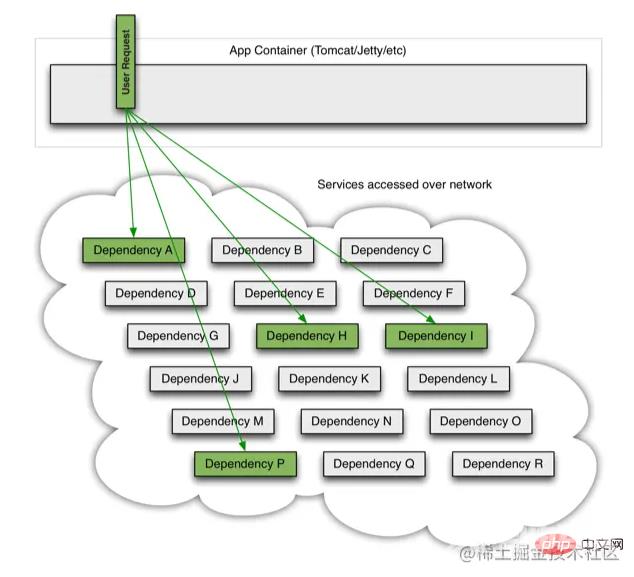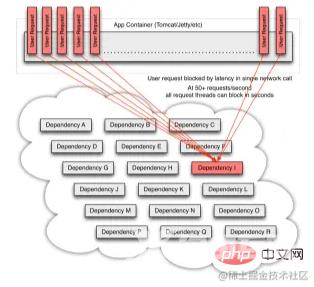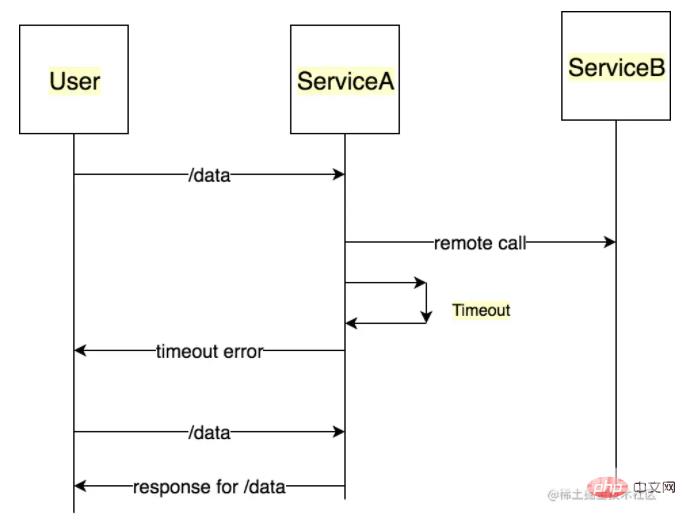本篇文章带大家了解一下Node.js中的断路器机制,希望对大家有所帮助!

当我们使用传统的 CS 架构时,服务端由于故障等原因将请求堵塞,可能会导致客户端的请求失去响应,进而在一段时间后导致一批用户无法获得服务。而这种情况可能影响范围是有限,可以预估的。
然而,在微服务体系下,您的服务器可能依赖了若干其他微服务,而这些微服务又依赖其它更多的微服务,这种情况下,某个服务对于下游的堵塞,可能会瞬间(数秒内)因为级联的资源消耗造成整条链路上灾难性的后果,我们称之为“服务血崩”。【推荐学习:《nodejs 教程》】


熔断模式:顾名思义,就如同家用电路一样,如果一条线路电压过高,保险丝会熔断,防止火灾。在使用熔断模式的系统中,如果发现上游服务调用慢,或者有大量超时的时候,直接中止对于该服务的调用,直接返回信息,快速释放资源。直至上游服务好转时再恢复调用。
- 隔离模式:将不同的资源或者服务的调用分割成几个不同的请求池,一个池子的资源被耗尽并不会影响其它资源的请求,防止某个单点的故障消耗完全部的资源。这是非常传统的一种容灾设计。
- 限流模式:熔断和隔离都是一种事后处置的方式,限流模式则可以在问题出现之前降低问题出现的概率。限流模式可以对某些服务的请求设置一个最高的 QPS 阈值,超出阈值的请求直接返回,不再占用资源处理。但是限流模式,并不能解决服务血崩的问题,因为往往引起血崩并不是因为请求的数量大,而是因为多个级联层数的放大。
断路器的存在,相当于给了我们一层保障,在调用稳定性欠佳,或者说很可能会调用失败的服务和资源时,断路器可以监视这些错误并且在达到一定阈值之后让请求失败,防止过度消耗资源。并且,断路器还拥有自动识别服务状态并恢复的功能,当上游服务恢复正常时,断路器可以自动判断并恢复正常请求。
让我们看一下一个没有断路器的请求过程: 用户依赖 ServiceA 来提供服务,ServiceA 又依赖 ServiceB 提供的服务,假设 ServiceB 此时出现了故障,在 10 分钟内,对于每个请求都会延迟 10 秒响应。

那么假设我们有 N 个 User 在请求 ServiceA 的服务时,几秒钟内,ServiceA 的资源就会因为对 ServiceB 发起的请求被挂起而消耗一空,从而拒绝 User 之后的任何请求。对于用户来说,这就等于 ServiceA 和 ServiceB 同时都出现了故障,引起了整条服务链路的崩溃。
而当我们在 ServiceA 上装上一个断路器后会怎么样呢?
断路器在失败次数达到一定阈值后会发现对 ServiceB 的请求已经无效,那么此时 ServiceA 就不需要继续对 ServiceB 进行请求,而是直接返回失败,或者使用其他Fallback 的备份数据。此时,断路器处于 开路 状态。
在一段时间过后,断路器会开始定时查询 ServiceB 是否已经恢复,此时,断路器处于 半开 状态。
如果 ServiceB 已经恢复,那么断路器会置于 关闭 状态,此时 ServiceA 会正常调用 ServiceB 并且返回结果。

断路器的状态图如下:

由此可见,断路器的几个核心要点如下:
超时时间:请求达到多久,算引起了一次失败
失败阈值:即断路器触发开路之前,需要达到的失败次数
重试超时:当断路器处于开路状态后,隔多久开始重新尝试请求,即进入半开状态
有了这些知识,我们可以尝试创建一个断路器:
class CircuitBreaker {
constructor(timeout, failureThreshold, retryTimePeriod) {
// We start in a closed state hoping that everything is fine
this.state = 'CLOSED';
// Number of failures we receive from the depended service before we change the state to 'OPEN'
this.failureThreshold = failureThreshold;
// Timeout for the API request.
this.timeout = timeout;
// Time period after which a fresh request be made to the dependent
// service to check if service is up.
this.retryTimePeriod = retryTimePeriod;
this.lastFailureTime = null;
this.failureCount = 0;
}
}构造断路器的状态机:
async call(urlToCall) {
// Determine the current state of the circuit.
this.setState();
switch (this.state) {
case 'OPEN':
// return cached response if no the circuit is in OPEN state
return { data: 'this is stale response' };
// Make the API request if the circuit is not OPEN
case 'HALF-OPEN':
case 'CLOSED':
try {
const response = await axios({
url: urlToCall,
timeout: this.timeout,
method: 'get',
});
// Yay!! the API responded fine. Lets reset everything.
this.reset();
return response;
} catch (err) {
// Uh-oh!! the call still failed. Lets update that in our records.
this.recordFailure();
throw new Error(err);
}
default:
console.log('This state should never be reached');
return 'unexpected state in the state machine';
}
}补充剩余功能:
// reset all the parameters to the initial state when circuit is initialized
reset() {
this.failureCount = 0;
this.lastFailureTime = null;
this.state = 'CLOSED';
}
// Set the current state of our circuit breaker.
setState() {
if (this.failureCount > this.failureThreshold) {
if ((Date.now() - this.lastFailureTime) > this.retryTimePeriod) {
this.state = 'HALF-OPEN';
} else {
this.state = 'OPEN';
}
} else {
this.state = 'CLOSED';
}
}
recordFailure() {
this.failureCount += 1;
this.lastFailureTime = Date.now();
}使用断路器时,只需要将请求包裹在断路器实例中的 Call 方法里调用即可:
...
const circuitBreaker = new CircuitBreaker(3000, 5, 2000);
const response = await circuitBreaker.call('http://0.0.0.0:8000/flakycall');成熟的 Node.js 断路器库Red Hat 很早就创建了一个名叫 Opossum 的成熟 Node.js 断路器实现,链接在此:Opossum 。对于分布式系统来说,使用这个库可以极大提升你的服务的容错能力,从根本上解决服务血崩的问题。
原文地址:https://juejin.cn/post/7019217344601948173
作者:ES2049 / 寻找奇点
更多编程相关知识,请访问:编程视频!!
